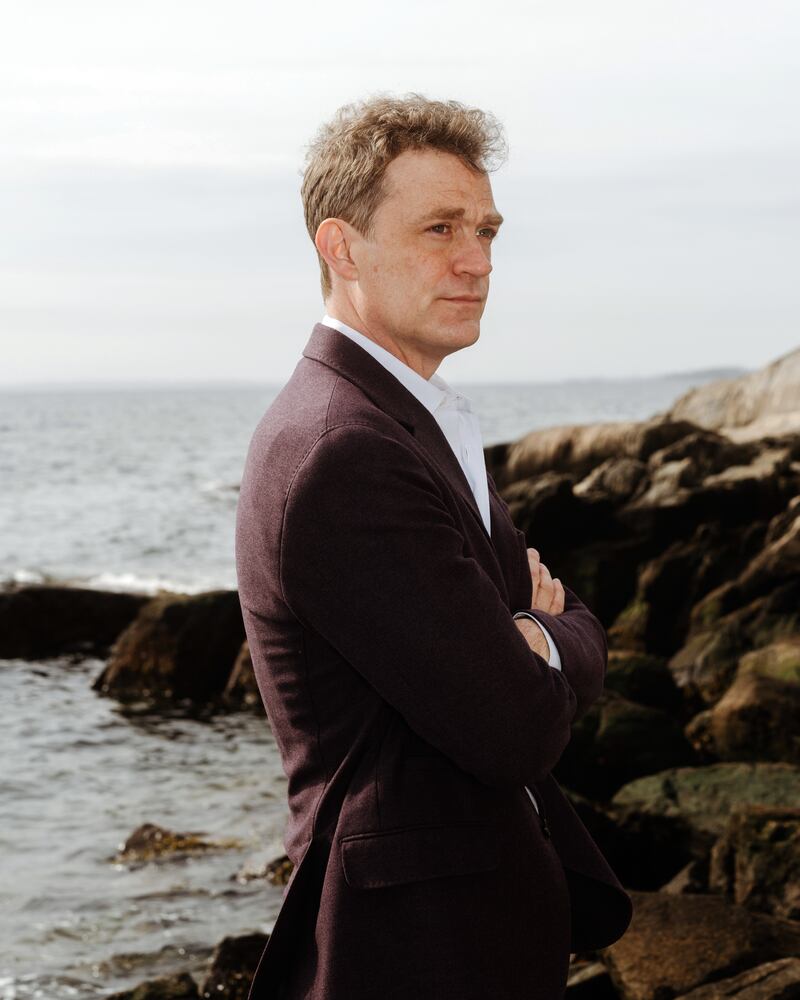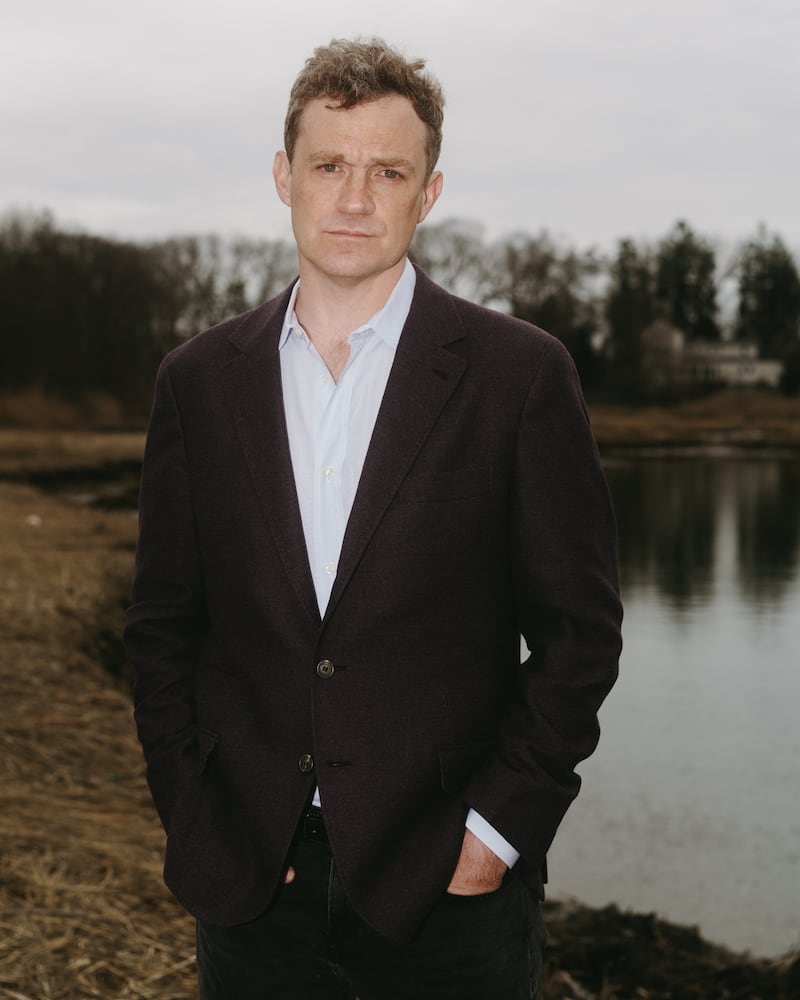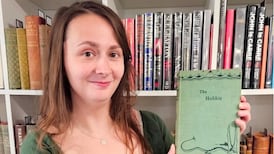Patrick Radden Keefe is an author who writes in deeply researched detail about a wide variety of dark subjects. His new book, Rogues: True Stories of Grifters, Killers, Rebels and Crooks, collects some of his New Yorker journalism and includes stories about cartel bosses such as El Chapo, arms dealers such as Monzer al-Kassar and mass shooters such as Amy Bishop. There are also profiles of banking whistleblowers, reality TV moguls and wine fraudsters. His other books include Say Nothing, which explores the moral haze of the Troubles, and Empire of Pain about how the Sacklers, a family of billionaire art philanthropists, fomented the American opioid crisis with their company Purdue Pharma.
I interview Keefe while he’s participating in the Borris Festival of Writing and Ideas in the living room of Borris House. It’s a stately room with a grand piano and ornate furniture. Outside the window we can see festival attendees wandering to and fro between marquees and we are sporadically interrupted by lost writers and documentary crews as we talk.
What does Keefe think connects his books? “Years ago, I had to get a very early taxi [and] you could hear the dispatcher having conversations. And at some point, one of the drivers said, ‘I’m going to stop at the doughnut place, do you want anything?’... My taxi driver turns to me and says, ‘He’s going to order a large coffee, one sugar, and two cinnamon doughnuts.’ And the guy hums and haws and then says, ‘A large coffee, one sugar. And that’s it... No, actually, you know what? Make it a cinnamon doughnut. You know what? Make it two cinnamon doughnuts.’”
He laughs. “The guy making the order thinks that he’s got free will but, of course, he’s totally programmed. A similar thing here. I do what interests me and it’s only in retrospect that you put them all together and realise: ‘I’ve only got two or three preoccupations.’”
READ MORE
Like what? “Some of it is about errant psychologies. It’s about the ways in which people transgress and then the stories that they tell themselves about how and why they do that.”

Keefe studied law at Yale and international relations at Cambridge but these things were just a “fallback”. He always wanted to write long-form journalism. His first New Yorker rejection letter is framed in his office. “I was a first-year student in college when the OJ Simpson verdict came down and there was a piece in the New Yorker... by Henry Louis Gates. He wrote a piece called Thirteen Ways of Looking at a Black Man where he was looking at the OJ Simpson verdict and he interviewed a whole series of prominent black intellectuals. It was a long piece that might take you 45 minutes to read and it just felt as though he’d taken an issue and just worked it from every conceivable point of view.”
He loves journalism that takes time. “You know, the Twitter abbreviation ‘TLDR? Too long, didn’t read’?” he asks. “I write a 10,000-word piece about a subject that feels inherently complex and people will say, ‘TLDR. What’s the gist?’ I wouldn’t have spent six months working on this if I felt that it could be fairly reduced to a bumper sticker.”
Does he feel that tradition of American long-form journalism is endangered by a world of hot takes? “I think what’s endangered is people spending the money and the time to do all the reporting. I’d say the average length of time I spent on a piece that’s in that book is probably six months of near full-time work... I’d interview 25, 30 sometimes 40 people for a piece. There’s a story in there about [the corporate exploitation of] Guinea where they sent me to West Africa, they sent me to France twice, they sent me to England... That stuff is expensive and I think it is endangered.”
He mentions writers who inspire him — people such as Janet Malcolm and Larissa MacFarquhar — who he sees as distinct from the sometimes ethically suspect “new journalism” exemplified by writers such as Truman Capote. “Capote would always talk about how he didn’t take notes, because he had the equivalent of photographic recall for dialogue. George Plimpton once joked that sometimes [Capote] would say he had 98 per cent perfect recall and sometimes it was 93 per cent. He knew his memory was perfect, he just couldn’t remember exactly how perfect it was.”
Keefe is less inclined to foreground himself in his stories. “I’m there in the background and there might be a moment or two where I intrude on the narrative. In the new journalism stuff, they’re everywhere and everything is played through them. In the moment when that stuff was written I think it was groundbreaking. To me from the perspective of 2022, it feels a little baggy and indulgent.”
He rarely tells the reader how to think or feel. “I find really didactic writing to be boring and patronising... I was mad as hell when I was writing [Empire of Pain]. It’s impossible not to be. And I know from readers that they get more and more angry as they read. But I think there’s a tone of writing that you saw a lot of in the Trump years, where the writer is furious and the reader is furious and we’re furious together and we commune in our fury and I really didn’t want to do that. It feels almost pornographic in its predictability... With this, I felt like the material is so shocking, I actually need to assume a very dry narrative voice. And occasionally you can see that I’m being a little withering or caustic but by and large, I’m just presenting it to you.”

The Troubles feel like a very different subject to the American opioid crisis. How does he think about the differences? “I sometimes think that Say Nothing is all about moral ambiguity and Empire of Pain is all about moral clarity,” he says. “Part of what drew me to Say Nothing was the idea that there was this generation of people who, in the early years of the Troubles, had a great deal of moral clarity. And they did some appalling things and then, later on in life, after the peace as they got older, they in some cases questioned those things they’d done. That was really intriguing to me. With the Sacklers, it’s the opposite. They have no ability to reflect in that way... There’s a sort of unadvertised disadvantage to being a billionaire, which is that you’re surrounded by these people who think it’s their job is to reaffirm every blinkered idea and bias.”
The Sacklers do not seem remotely morally troubled unlike most people who feature in Say Nothing. “That’s part of what’s so intriguing. If anything, [Gerry] Adams is sort of more similar to the Sacklers in the sense that he seems to sleep quite well at night, thank you very much. There’s this sort of implacability to both of them.”
What sparked the writing of Say Nothing? “I read this obituary of Dolours Price. I had never heard of her. And I’d never heard of Jean McConville... I had thought of the history of the hunger strikes and of the Provos as a very male history... And then I was interested in the idea that there were people who felt very disaffected after the peace process.”
He used the murder of McConville as the throughline to explore the ascendency of politically ambitious republicans such as Adams, the hurt of the victims of violence and the moral ambivalence felt by former combatants such as Price and Brendan Hughes. I tell him I found it moving and unsettling. “It’s unsettling because you find yourself rooting for Brendan Hughes at a certain point and then he goes and does Bloody Friday and you feel implicated... There’s a way to tell this story where you capture what for them was the romance and glamour of what they were doing, but you’re not romanticising it yourself, you’re not glamorising it yourself. You don’t avert your eyes from the awfulness of what they end up doing.”
Was being an outsider an advantage? “I think it was hard for people to plot me on any ideological grid in a way that if I lived there might have been different... One of my great advantages is I’m going to leave in the end... I had a freedom to speak the truth and say the uncomfortable thing, probably in part because I don’t have to go back and live in west Belfast.”
In the preface of Rogues he talks about getting a call from El Chapo’s lawyer which momentarily alarms him - El Chapo wanted him to co-write his memoirs; he declined. He has written extensively about criminals and terrorists. While writing Empire of Pain, Keefe was subject to legal threats and, at one point, found himself being monitored by a strange man in a car. “The timing seemed,” he pauses, “interesting.”
Does he often feel in danger while reporting? He laughs. “There is a lamentable tradition of journalists overdramatising their own heroism and that’s not me. I have a pretty low risk threshold, actually. I’m pretty careful. I trained as a lawyer. I think about risk. I have none of the heroism of a war reporter. If there were situations in which I felt as though I would be in serious physical danger, I would be quite careful. I have kids.”
Why was he so interested in the Sacklers? “I had written a lot about the illegal drug trade [and] you suddenly had all this Mexican heroin coming into the US from illegal cartels. But the reason they were sending all the Mexican heroin was that there was new demand [from] people who’d had an on ramp with OxyContin and other FDA regulated drugs.”
There had been a lot written about the opioid crisis before Empire of Pain. Why does he think the Sacklers largely escaped scrutiny despite their company’s aggressive and dishonest marketing of OxyContin? “The books that had been written about the opioid crisis, up to that point, pretty much without exception, had taken this approach where you interweave a series of different stories... The Sacklers would occasionally be presented as one strand... If you’ve ever seen a children’s play, there’s always some child who’s ‘Villager Number Three’ who clearly has stage fright, doesn’t want to be there, and stands very still at the edge of the stage. [The Sacklers] were there but they weren’t centre stage. They were just sort of hoping nobody would notice.”
The Sackler name has now been stripped from many institutions and art galleries who benefited from their philanthropy (partly due to “die-in” campaigns by artists such as Nan Goldin), but it took a while. Keefe is realistic about the limits of journalism. “I had this wild experience a few months back when the book was shortlisted for the FT Business Book of the Year award,” he says.
“I went to London for the event where they would announce the winner... It was the FT/McKinsey award so there’s a low level of irony because McKinsey [who advised Purdue] is one of the villains in the book... Everybody’s all gussied up and having champagne in this room that’s right next to the Sackler Room in the National Gallery... I was next to the Sackler Room at this McKinsey-funded event. I didn’t win but there was a £10,000 fee for the finalists and I donated the money to an opioid treatment centre. But what if I had taken the money? I would have been just as guilty as everyone else.”
















